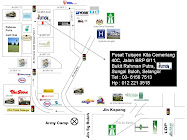Pusat Tuisyen Kita Cemerlang
名詞片語 (Noun Phrase)
一個名詞片語包含一個名詞 (這還用說嗎!?) 和任何相關的修飾語:
The long and winding road
A noun phrase
any associated modifiers
講到名詞片語,有件事我們要必須注意,那就是冗長的複合名詞片語;這種片語有時被稱為「堆積」或「擁擠」(stacked or packed) 名詞片語。我們經常會見到一個名詞修飾另一個名詞:student body, book cover, water commission. 但當我們創造了一長串當形容詞用的名詞 (attributive nouns) 或修飾語時,我們也成為「問題的製造者」:
People who author web-pages have become aware of what is now known as the uniform resource locator protocol problem.
在這個句子中,我們真的難以瞭解那個名詞修飾那個名詞。再者,讀者一直在期待字串的結束,因此句子的能量 (和我們的注意力) 無法集中,重點強調不出來。在科技文章的寫作中,這種片語特別常見。一般而言,一個冗長複合名詞片語的解決之道是,將字串的最後一個名詞拿到句子的開頭並將至少一個修飾用的名詞變成介系詞片語 (這是一種把句子變得長一點可能比較好的情況):
The problem with the protocol of uniform resource locators is now recognized by people who author web-pages as. . .
呼格或稱呼語 (vocative)通常是名詞單字,但具有名詞片語形式 。稱呼語都被視為插入語句,因此以一個逗點或一對逗點 (如果它出現在句子中間的話) 與句子其他部分分開。稱呼語與副詞一樣,幾乎可以出現在句子的任何地方。然而,別養成在人名的地方加逗點的習慣;除非某一名字指的是甫被稱呼的某人,否則它並非稱呼語,因此就不必以插句的形式存在:
He told Jorge to turn the boat around.
Jorge, turn the boat around.
稱呼語大致可分為四種:
1. 有頭銜或沒有頭銜的單名:Mr. Valdez, Dr. Valdez, Uncle, Grandma. "Dr. Valdez, will you please address the graduates?"
2. 人稱代名詞 you (不是一種禮貌的稱呼):"You, put down that gun!" 第二人稱代名詞通常與其他字合用,但結果往往相當粗魯無禮,因此從不在正式文章中使用 ("You over there, hurry up!" "You with the purple hair and silver nose rings, get back in line!")
不定代名詞 (indefinite pronoun;如 some, any, somebody 等)也可作為稱呼語:"Call an ambulance, somebody!" "Quick, anybody! Give me a hand!"
3. 親愛的稱呼語 (Darling, Sweetheart, Love, My dear):"Come sit next to me, my dear."
尊敬的稱呼語 (Sir, Madam, Your Honor, Ladies and gentlemen):"I would ask you, Sir, never to do that again."
職業或地位的稱呼語 (Professor, Mr. President, Madam Chairman, Coach):Please, Coach, let me play for a while.
4. 名詞子句 (nominal clause):Whoever is making that noise, stop it now.
skip to main |
skip to sidebar



pusattuisyenkitacemerlang@yahoo.com
We provide 1. Quality Teaching To Encourage Your Child's Learning Desire. 2. Quality Learning To Build Your Child's Self Confidence. 3.Quality Growing To Shape Your Child's Future. Email: pusattuisyenkitacemerlang@yahoo.com
Principal

Motivator and Academic Counselor

Location

pusattuisyenkitacemerlang@yahoo.com
Sharing Subjects
- Adat Melayu (6)
- B.Melayu - Karangan (1)
- KC 伟 杰 课 室 (25)
- KC 伟 杰 课 室 Proverb (17)
- KC 伟 杰 课 室 Reborn (15)
- KC 伟 杰 课 室- Travel (1)
- KC 伟 杰 课 室-出国留学 (14)
- KC 伟杰课室 - 教育 (10)
- KC 伟杰课室学习 (8)
- Kita Cemerlang (12)
- Kita Cemerlang - Sharing (106)
- Kita Cemerlang 雙溪毛糯- Work? (10)
- Komsas (6)
- Math Reference Tables (10)
- Maths Olympics (8)
- Photos (4)
- PMR - BM作文 (12)
- PMR - 华文 (17)
- PMR - 华文作文 (25)
- PMR - 英语 (1)
- PMR - 英语作文 (6)
- PMR-华语-孔子 (4)
- Science - Chemistry (9)
- SPM - B. M-Tatabahasa (2)
- SPM - BM作文 (20)
- SPM 华文 (4)
- SPM 华文作文 (3)
- STPM 华文 (4)
- STPM 华文作文 (1)
- Teacher (7)
- UPSR - 华语 (2)
- UPSR - 华语作文 (54)
- UPSR - 成语故事 (9)
- UPSR B.English (13)
- UPSR B.English - Grammar (28)
- UPSR B.English - Story (7)
- UPSR B.English Essay (16)
- UPSR B.M- Nilai Murni (5)
- UPSR B.Melayu (3)
- UPSR B.Melayu - Karangan (15)
- UPSR B.Melayu - Tatabahasa (20)
- UPSR Mathematic (11)
- UPSR- 华语 (39)
- UPSR- 华语古文 (21)
- UPSR- 科学 (17)